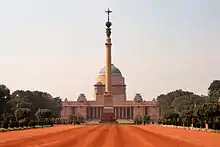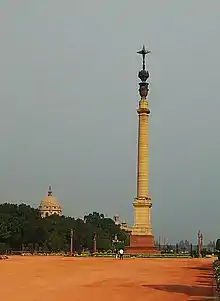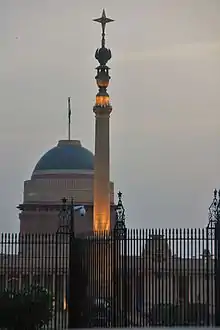Jaipur Column
The Jaipur Column is a monumental column in the middle of the courtyard in front of Rashtrapati Bhavan, the presidential residence in New Delhi, Delhi, India. In 1912 Madho Singh II, the Maharaja of Jaipur, offered to sponsor its construction to commemorate the 1911 Delhi Durbar and the transfer of the capital of India from Calcutta to Delhi.[1]

The column was designed by the British architect Sir Edwin Lutyens. In 1920, Lutyens submitted his design for the column to the Royal Academy of Arts in London, as his diploma work for his election as a fellow of the academy. The structure was completed in 1930.[1]
The column is predominantly made of cream sandstone, with red sandstone used for the base. At the top there is an egg surmounted by a bronze lotus flower and a six-pointed glass star. These are supported by a steel shaft running through the column's entire length.[1] Different sources give the height as 145 feet (44 m)[2] or 148 feet (45 m).[1]

There are bas-reliefs around the base, designed by the British sculptor Charles Sargeant Jagger.[1] Jagger also designed the elephants carved into the walls around the courtyard,[3] as well as the statue of George V, Emperor of India which formerly stood under the canopy next to India Gate.[1]

On the base there is an inscription, with wording supplied by Lord Irwin, the Viceroy of India:[4]
- In thought faith
- In word wisdom
- In deed courage
- In life service
- So may India be great
This was a modification of the wording originally proposed by Lutyens:[4]
- Endow your thought with faith
- Your deed with courage
- Your life with sacrifice
- So all men may know
- The greatness of India
 An egg surmounted by a bronze lotus flower and a six-pointed glass star
An egg surmounted by a bronze lotus flower and a six-pointed glass star The first stones were led by The king Emperor George The Fifth and his consort Queen Mary on the 15 December 1911
The first stones were led by The king Emperor George The Fifth and his consort Queen Mary on the 15 December 1911 Bas-reliefs around the base, designed by the British sculptor Charles Sargeant Jagger
Bas-reliefs around the base, designed by the British sculptor Charles Sargeant Jagger As per writeup on the column-Madho Singh II, the Maharaja of Jaipur, offered to sponsor its construction to commemorate the 1911 Delhi Durbar and the transfer of the capital of India from Calcutta to Delhi
As per writeup on the column-Madho Singh II, the Maharaja of Jaipur, offered to sponsor its construction to commemorate the 1911 Delhi Durbar and the transfer of the capital of India from Calcutta to Delhi
Notes
- Amery, Richardson and Stamp (1981), pp. 179–80.
- de Bruyn, Bain, Allardice and Joshi (2010), p. 429.
- Amery, Richardson and Stamp (1981), p. 172.
- Singh and Rai (1983), p. 41.
References
- Amery, Colin; Richardson, Margaret; Stamp, Gavin (1981). Lutyens: The Work of the English Architect Sir Edwin Lutyens (1869–1944). London: Arts Council of Great Britain. ISBN 0-7287-0304-1.
- de Bruyn, Pippa; Bain, Keith; Allardice, David; Joshi, Shonar (2010). Frommer's India. Hoboken: John Wiley & Sons. ISBN 978-0-470-55610-8.
- Singh, Khushwant; Rai, Raghu (1983). Delhi: a portrait. Delhi: Delhi Tourism Development Corporation. ISBN 0195614372.